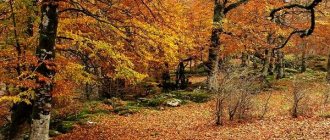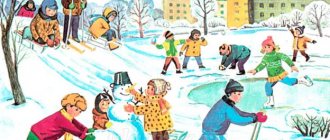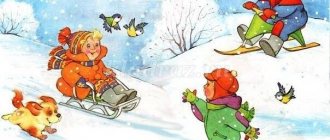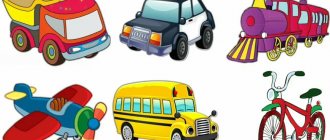Spring dimension
Its goal is to continue acquaintance with various natural phenomena, improve the ability to distinguish weather, and connect it with the features of the sky.
The outline of a walk in the middle group in the spring includes the development of children's attentiveness, maintaining a gracious, joyful, excellent mood, and the formation of concepts about the changing seasons.
Card index of outdoor games on a spring walk for children of middle preschool age
Anastasia Shvets
Card index of outdoor games on a spring walk for children of middle preschool age
Outdoor games on a spring walk.
Middle preschool age.
“Burn, burn clearly!”
Goal: develop speed and agility
Move: players stand in a column of two, holding hands, in front of the column is the leader. Children say in chorus:
Burn, burn clearly so that it doesn’t go out.
Look at the sky: the birds are flying,
The bells are ringing!
One, two, three - run!
At the end of the words, the players of the last pair lower their hands and run to the beginning of the column - one to the right, the other to the left of it. The driver tries to stain one of the players before he has time to join hands with his partner. If the driver has stained the player, then he pairs up with him at the front of the column.
"Birds and Chicks"
Goal: to develop in children the execution of movements on a signal. Practice running in different directions without touching each other.
Progress: children are divided into 3 - 4 groups; Each group has its own nest house. Each group of “chicks”
there is a mother bird.
According to the teacher’s word “fly”,
the chicks fly out of the nest.
According to the teacher’s word “home,”
the mother birds return and call the chicks home. In the nest, the chicks sit in a circle. The game is played 3 – 4 times.
"Find your color"
Goal: to develop in children attention , the ability to distinguish colors and act on a signal. Practice walking and running.
Progress: children receive flags of three or four colors: red, blue and yellow and are grouped in groups of 4-6 people in different corners of the site. In each corner, the teacher places a colored flag (red, blue, yellow)
.
At the teacher’s signal “go for a walk,”
the children disperse around the playground.
When the teacher says “find your color,”
the children gather near the flag of the corresponding color. Game duration is 4 – 5 minutes.
"Find yourself a mate"
Goal: to develop spatial orientation children Exercise children in running .
Progress: Each child receives one flag. There are equal numbers of flags of two colors. At the teacher’s signal, the children scatter around the playground. On the signal “find a pair”
Children with the same flags stand next to each other.
of children must take part in the game so that one is left without a pair.
Turning to him, all the players say: Vanya, Vanya, don’t yawn (Tanya, Olya and others.)
Choose a pair quickly!
Then, when the tambourine is hit, the children scatter around the playground again, and the game is repeated. Game duration is 5-7 minutes.
"Let's jump over the stream"
Goal: to practice standing long jumps.
Progress: a stream is drawn on the site, narrow at one end, and then wider and wider (from 10 to 40 cm)
A group of
children is asked to jump over a stream, first where it is narrow, and then where it is wider, and finally where it is widest.
Game duration is 5 – 6 minutes. "We are funny guys "
Goal: to develop speed and agility.
Procedure: children stand on one side of the playground outside the line. A second line is drawn on the opposite side of the site. There is a trap in the center of the site. The driver is appointed by the teacher or chosen by the children. The children say in chorus:
We are funny guys
We love to run and jump.
Well, try to catch up with us.
One, two, three - catch it!
After the word "catch"
the children run to the other side of the playground, and the trap catches up with the runners and catches them. The one whom the trap manages to touch before the runner crosses the line is considered caught.
"Run to what I call"
Goal: to train in quickly finding the named object on the site or in the room; develop fast running in a flock, attention.
Move: a driver is selected, the children stand next to him and listen to what he says. The driver explains: “Where I say, you will run there and wait for me. ”
, then says:
“One, two, three, run to the sandbox!”
The driver carefully monitors the children; whoever runs to the wrong object is taken to the penalty box.
The game repeats itself. (children run to the table, to any tree, to the veranda.)
“Cosmonauts”
Goal: to develop children's attention , dexterity, and imagination. Exercise orientation in space.
Progress: the contours of the missiles are drawn along the edges of the platform. The total number of seats in the rockets must be less than the number of children . In the middle of the platform, the astronauts, holding hands, walk in a circle, saying:
Fast rockets are waiting for us
Let's fly to this one!
For walks on the planets .
But there is one secret in the game:
Whatever we want
There is no room for latecomers.
With the last words, the children let go of their hands and run to take their places in the rocket. Those who did not have enough space in the rockets remain at the cosmodrome, and those who are sitting in the rockets take turns telling where they are flying and what they see. After that, everyone stands in a circle again and the game repeats.
Progress of the walk
The summary of the target walk in the middle group in the spring includes the kids guessing riddles:
“What kind of ceiling is this that is neither low nor high? It is gray and whitish, sometimes beautiful, sometimes sad (the sky).” Next, the teacher invites the kids to look at it and evaluate the day. Kids select adjectives for the state of the sky: sad, blue, gray, sad, happy.
In the summary of a walk in the middle group in the spring, you can include the following speech for the teacher: “Guys, if the sky is blue, what will the weather be like?” The kids answer that if there is sun in the sky, the weather will be warm and joyful. Gray skies suggest a sad and cloudy mood, a sad day.
Next, the teacher asks his students on what day they most want to go for a walk, and why? The teacher offers the preschoolers a poem:
What's happened? What's the matter?
The sky suddenly turned blue,
Suddenly the evil cold went away...
There are still puddles in the yard...
Who is to blame for everything here?
Of course, the month is March.
The teacher asks the kids about what time of year is mentioned in this poem. Preschoolers answer the teacher that we are talking about spring. Next, the teacher asks questions:
- What other months do you know?
- What characterizes each month?
- What are the signs of spring?
- Where does the snow go?
- Why does it get warm in spring?
Next, the kids are shown the “Find a thawed patch” experiment. Its goal is to consolidate the properties of snow, develop observation skills, and develop cognitive interest in natural phenomena. In the area of the kindergarten designated for walking, the children, together with the teacher, look for thawed patches. They are trying to understand why they appear in these places. The teacher leads the children to the conclusion that thawed patches appear only where the bright sun shines. Next, the teacher conducts an entertaining experience for his students. He puts some of the snow in a sunny place and leaves some in the shade. The kids, together with their teacher, carefully observe the changes that occur with the snow and draw conclusions about the influence of temperature on the process of snow melting.
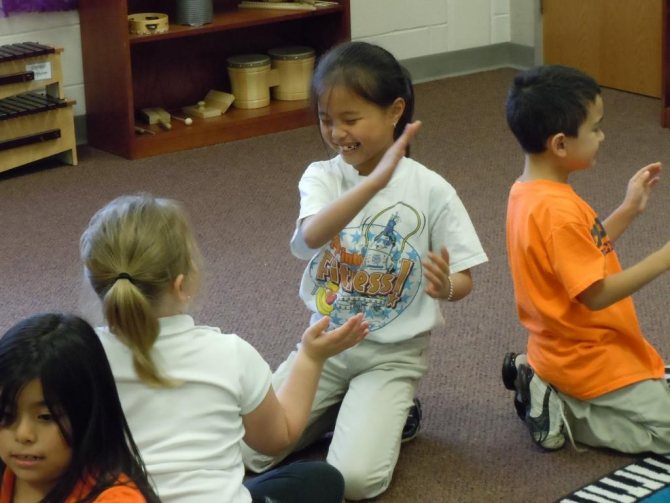
MAGAZINE Preschooler.RF
Educator: Tselishcheva T.S. 2014 Walk in the middle group. Theme: Spring is red. Goal: Continue acquaintance with various natural phenomena; improve your ability to distinguish the weather. Develop mindfulness. Maintain a joyful, gracious, good mood. Progress of the walk. - Let's say hello to the guests. Today is a joyful day! Really, guys? Do you know why there is joy in our group? Joy ran along the path Joy opened all the windows Joy woke up all the children Joy invited guests to us. — We stood on the meadow and made a circle.Surprise moment: A swallow flies to the children with tasks. (child, a cap on his head.) The swallow recites his poem. (The grass turns green...) Listen to the riddle. The snowball is melting The meadow has come to life, The day is coming When does this happen? (In spring) Questions from the swallow: 1. How many spring months are there (3) 2. . Which? In chorus: March, April and May - don’t forget them 3. What warms, shines, scorches in the spring? (Sun) 4. What is hanging from the roof, dripping, melting? (icicle) 5. In the spring does it melt, cry, settle? (snowman) 6. what gets dark in the spring, melts, runs away with water (snow) 7. what runs, murmurs, sings in the spring (stream) 8. a flower growing from under the snow (snowdrop) 9. birds that fly away in the fall and arrive in the spring (migratory) 10. a piece of land where the snow melted? (thawed patch) 11. What are you wearing. Signs of spring: - In ancient times, people observed changes in nature, its phenomena, plants, birds, caught and remembered various signs. Here's what they said: Early spring has a lot of water. I saw a rook - welcome spring. The snow will melt soon - for a wet summer. - Spring has come to us. Have you already guessed that we will talk about WHAT today? People have long loved spring. They called it spring - red. All nature wakes up in spring, after the winter cold. Green grass appears, the first flowers appear, birds fly in.
The teacher invites the children to compose a “Portrait of Spring”
Vos: - Spring is the transition from winter to summer. Child 1: - The sun is shining brightly and hot. (sun) 2: - The buds are swelling on the trees and small leaves are appearing. (trees) 3: - Birds are returning from warm regions. (birds) Music 3: - The ice on the rivers also melts, it breaks into ice floes and floats down the river. They say there is ice drift on the river. (ice drift) 5: - Melted snow creates cheerful streams and large puddles (Streams) 6: - Thaw is a place where the snow has melted and the earth has opened up. 7: - In the forest, in the thawed areas, the first flowers appear - snowdrops (snowdrops) 8: - The snow begins to melt, icicles appear, drops ring. (icicles) - Guys, listen to the music. And think about what it reminds you of? Music - What kind of spring have we had? children's answers (cheerful, ringing, fragile, transparent, shiny) Poems about spring.
1. “The snow is melting.” the snow has melted, the snow has melted, This is not easy news, This means the Real Spring is coming! 2. “The day is longer.” Every day, every minute, the day is longer, the night is shorter. We are slowly driving Winter away!
3. Drops begin. The spruce has warmed up in the sun, the pine has melted, April is coming, the drops are ringing, It’s spring in our forest!
4. Birds arrive. The last snow in April is melting. Everyone is happy about the sun and spring, Spring arrives in April, With a cheerful swallow coming to me! Outdoor game: “Planes” (4 times) Purpose: To develop the ability to navigate in space and move without bumping into each other. Progress of the game: Children are divided into four units and placed at different ends of the site. Each person is given homemade airplanes (yellow, green, black, orange). The players portray pilots.
At the teacher’s command “Get ready to fly!” the children make circular movements with their arms, says the teacher, they raise their arms to the sides and run in different directions throughout the entire area. “Planes are flying and don’t want to land on the ground. They are flying merrily in the sky, but they won’t collide with each other. Suddenly a large cloud flies in. It has become dark all around. Planes - form a circle” (planes of the same color line up in a circle and go down on one knee). The teacher notes which link was built faster. 3. Labor activity. Collect waste on site into boxes. — Guys, there was a wind at night and visited our site and brought garbage. Let's remove it together. 4. Individual work.
“Throw it to the skies” (ball game) Goal: Improve the ability to throw and catch the ball. Promote the development of motor skills. Develop dexterity and attention. Children are divided into groups. They toss the ball.
Games based on interests.
| Next > |
Seasonal walk. Spring. Middle group.
Equipment: ball, shovels, bird treats, hare mask, hoop with ribbons, cones, box of candy.
Progress of the walk.
Guys, I want to ask you a riddle:
The sun is warming up The snow is melting When does this happen?
That's right in the spring! And what month of spring now rules, as it is called, the very first month of spring. Child:
Mother Spring is coming Open the gates March came first The white snow has melted
And what other month can this month be named according to the folk calendar? (pre-spring, protalnik) Who wants to tell a poem about the month of March. Child:
Although March is a crybaby And a big cunning One eye is in tears And in the rays of the other.
And what do you and I know about the first signs of spring?
(the teacher throws the ball to the children in a circle)
• Drops are ringing • Melt water • Thaw • Blue sky • Daylight increases • Thaws • Birds rejoice • The sun shines brightly • Icicles
-Let's ask how spring is doing? Q: How's spring going? D: I have cleaning to do. Q: What do you need a broom for? D: Sweep the snow from the hillock. Q: What do you need streams for? D : Wash away the trash from the paths. Q: What do you need the rays for? D: Same for cleaning. Q: The sun is working, helping spring. Let's remember the proverbs about work. D: You’ve done the job, walk boldly. You won’t be able to pull a fish out of the pond without difficulty. Let's take shovels and help the snow melt (Children's work at the site with a teacher) Educator: The rays of the sun are warm and nimble. They grew up and began to ask the sun to let them go for a walk on the ground. The sun thought and released rays. The baby's rays scattered to visit the children.
The children walked around the yard, watched nature, looked up at the sun, and their rays warmed them.
Pull up your palms, feel how the little rays caress and warm your hands. They are the ones who greet you. Show them your rays. Let the warm rays warm them. The rays also hit the birds. Let's put some bread crumbs in their feeder. But they won't be coming soon. How can you figure out why? Children: They will find their own food, because spring has come and they feel warm and happy. Educator: A ray of sunshine hit the bunny.
Let's play the game "Grey Bunny Wash Yourself"
Guys, if you want to ride the carousel with me, look how wonderful the spring weather is today.
Game "Carousel" (ribbons attached to the hoop)
Barely, barely, barely the carousel spun And then, then, then everyone ran, ran, ran. Hush, hush, don't write off the carousel, stop it. One-two, one-two The game is over.
Educator: I have a surprise for you. But only then will you receive it when you hold hands and walk like a snake between the cones. Be careful and walk carefully.
(cones are scattered throughout the area)
Children find a box of sweets.
Educator: Let's all say together: Come spring, come beauty, come on, sunshine, little bell! Children, now we will draw what interesting things we learned on our walk today or what we remembered and liked most.
Author: Zoya Viktorovna Ovchinnikova, teacher, MBDOU d/s “Luchik” combined type, Bolkhov, Oryol region, Russia
The article is published in the author's edition
